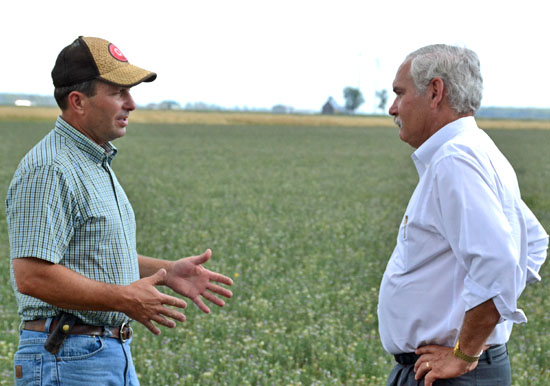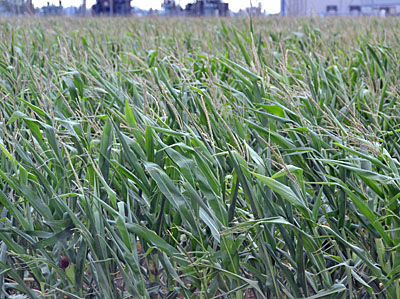USDA official sees results of drought
DAVE MOSIER/independent editor

U.S. Department of Agriculture Under Secretary Michael Scuse came to the area to look at drought-damaged crops. It was a sobering experience.
“It was worse than what I had anticipated coming out here,” Scuse said while looking at a drought-stunted alfalfa field near Haviland owned by Roy Klopfenstein. “I knew it was going to be bad but I didn’t realize it was going to be as bad as what I’ve seen.”
The drought conditions have had a crippling effect on local crops, especially the corn crop, which has been hit by a combination of high temperatures and low moisture at a time when the plants are beginning to form ears.
Scuse said he’s seen soybean plants that didn’t have enough moisture to germinate and corn stalks that don’t have any ears on them.
The USDA official said he didn’t have much hopes for much of the local corn crop. “I think for the corn crop, for much of it, the damage is so far along that even if we had a tremendous amount of rainfall I don’t know that it would be of much help,” Scuse said, but noted that, even then, the damage is spotty. “There are some fields that I have seen that will be a total loss, (but) there are some fields out there where the corn, there is an ear on it, it did pollinate, there’s, I think, still enough life left in the plant where, if we did get rain, they might be able to salvage a percentage of the crop.”
That won’t help the plants where ears didn’t form, though, Scuse noted, adding that he has seen 4-foot plants that have no ears whatsoever. The high temperatures have also negatively affected pollination, Scuse said. “The 100-degree heat doesn’t help the pollination process,” he noted, and pointed to Klopfenstein’s alfalfa field, noting that it’s hard for farmers to decide whether to harvest now or leave the plants alone. “With alfalfa, if you cut it now and it doesn’t rain, it probably won’t recover,” the USDA official said.
Van Wert County Agriculture Extension Agent Curtis Young was also somewhat pessimistic about local crops, especially the corn.
“It’s pretty tough on the corn right now,” Young said, noting that corn crop quality gets worse the closer one gets to Indiana, although it’s not great anywhere in the county.
“If they have an ear at all, they are going to be relatively small and the kernels are not going to be very well filled out,” Young said. “That all requires water and we really haven’t had any.”
Although he said he doesn’t like to make predictions, OSU Extension agent said corn yields don’t look good locally.
“At this point, it’s pretty poor … it may be next to nothing to come out of some of these fields,” Young said, adding that other fields could see yields that are only half of what was originally expected.
On the other hand, the OSU ag agent said there is still hope for local soybean crops, largely because the germination process extends over a greater period and plants have far more flexibility in how germination occurs.
Of course, the drought conditions are nothing new, with Young noting weather conditions tend to run in cycles. Both he and Scuse likened this year’s drought conditions, though, to that of 1988, one of the most severe droughts on record.

Scuse, who was in Michigan on Monday before Tuesday’s visit to Paulding County, said he would continue his inspection in Indiana today before heading back to Washington.
The USDA official recommended that farmers who know they’re going to have a loss need to contact their crop insurance agents as soon as possible, but he also wondered if there were enough adjusters available to assess all the damage.
From the USDA’s standpoint, Scuse said Congress needs to pass the much-delayed farm bill. “We need a farm bill as soon as we can possibly get one,” he said, noting that there are programs in both the Senate and House versions of the bill that could aid farmers suffering from the drought.
Meanwhile, the lost corn could also drive prices of a number of consumer items up, since corn is used in a variety of products. The lack of feed for corn-fed livestock, such as beef, could also result in a thinning of herds and the resulting higher prices on meat and dairy products.
But despite the corn crop damage — and potential for even greater crop losses down the road, if farmers don’t get rain soon — Scuse said there were still some positives to be gleaned.
“”This is not the time to panic,” he said, noting that, even with an unheard of 20-bushel per acre cut in the most recent corn forecast, there are also a record number of acres planted in corn this year, thanks to optimum planting conditions earlier this year.
“Let’s put this in proper perspective; yes, it’s bad, but with the record number of corn acres and based on the latest numbers, this would still be the third largest corn crop in history,” Scuse noted.
POSTED: 07/18/12 at 6:56 am. FILED UNDER: News







